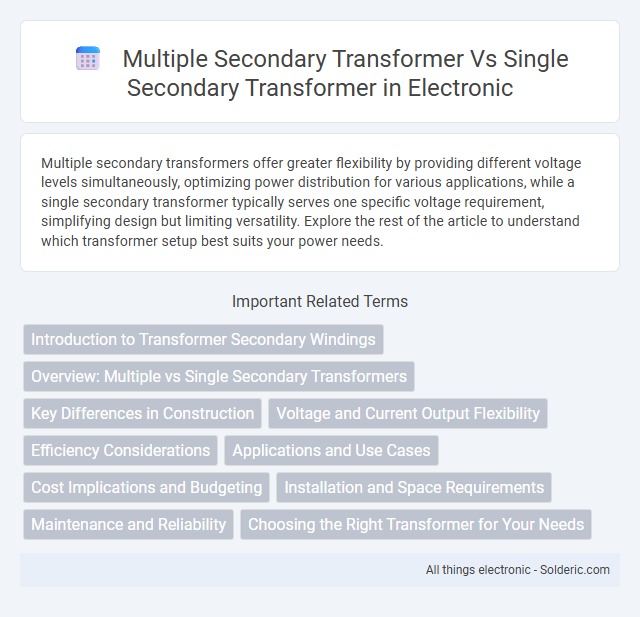Multiple secondary transformers offer greater flexibility by providing different voltage levels simultaneously, optimizing power distribution for various applications, while a single secondary transformer typically serves one specific voltage requirement, simplifying design but limiting versatility. Explore the rest of the article to understand which transformer setup best suits your power needs.
Comparison Table
| Feature | Multiple Secondary Transformer | Single Secondary Transformer |
|---|---|---|
| Design Complexity | Higher due to multiple secondary windings or separate transformers | Simpler with one secondary winding |
| Cost | Typically higher because of multiple components | Lower due to fewer materials and parts |
| Flexibility | High; supports various output voltages and current ratings | Limited to a single output voltage and current |
| Isolation | Better isolation between secondary outputs | Common ground/shared isolation across outputs |
| Maintenance | More complex, multiple units to monitor or replace | Simpler, single unit maintenance |
| Size and Weight | Generally larger and heavier when combined | Compact and lighter |
| Efficiency | Comparable, but can vary depending on load distribution | Consistent efficiency under single load conditions |
| Common Applications | Complex power supplies, multi-voltage systems | Simple power supplies, single-voltage systems |
Introduction to Transformer Secondary Windings
Multiple secondary transformers offer distinct voltage outputs from separate windings, providing flexibility in electrical applications where varied voltage levels are required simultaneously. Single secondary transformers feature one secondary winding, supplying a singular voltage output suited for consistent, uniform power needs. The choice between multiple and single secondary windings impacts system design, efficiency, and adaptability in power distribution networks.
Overview: Multiple vs Single Secondary Transformers
Multiple secondary transformers provide distinct voltage outputs from separate windings, allowing for versatile power distribution and tailored voltage levels in complex electrical systems. Single secondary transformers offer a singular voltage output, simplifying design and improving efficiency where only one voltage level is needed. Your choice depends on system requirements, where multiple secondary transformers enhance flexibility and single secondary transformers optimize cost and simplicity.
Key Differences in Construction
Multiple secondary transformers feature separate secondary coils wound independently on the same core, allowing different voltage outputs and isolation between circuits. A single secondary transformer contains one secondary winding that provides a single output voltage, making it simpler but less flexible. Your choice depends on the required number of output voltages and the need for electrical isolation between devices.
Voltage and Current Output Flexibility
Multiple secondary transformers provide enhanced voltage and current output flexibility by offering several distinct voltage levels and current ratings from a single primary winding, allowing tailored power delivery for diverse applications. In contrast, a single secondary transformer delivers fixed voltage and current outputs, limiting adaptability to different load requirements. Your choice impacts system design efficiency, with multiple secondaries enabling more precise control over voltage regulation and current distribution.
Efficiency Considerations
Multiple secondary transformers can improve overall system efficiency by distributing the load more evenly and reducing losses associated with high current flow in a single transformer. Single secondary transformers may experience higher thermal stress and increased core losses under varying load conditions, leading to reduced efficiency. Optimizing your power distribution with multiple secondary transformers often results in better voltage regulation and energy savings.
Applications and Use Cases
Multiple secondary transformers enable simultaneous power distribution across different voltage levels, ideal for complex industrial systems requiring varied voltage outputs. Single secondary transformers are commonly used in simpler applications where a consistent and stable voltage output is sufficient, such as residential power supply or small-scale commercial operations. The versatility of multiple secondary transformers makes them essential in scenarios demanding multi-voltage systems, like manufacturing plants and renewable energy integration.
Cost Implications and Budgeting
Multiple secondary transformers generally increase initial capital expenditure due to the need for additional units, installation, and maintenance compared to a single secondary transformer. However, they offer improved system flexibility and redundancy, potentially reducing long-term operational costs and downtime expenses. Budgeting must account for higher upfront investment but can benefit from scalability and targeted load management, which may optimize overall financial performance in complex electrical systems.
Installation and Space Requirements
Multiple secondary transformers require more installation space due to the need for separate enclosures, wiring, and mounting compared to a single secondary transformer system. This configuration can increase the complexity of the electrical layout and may demand additional clearance for safe operation and maintenance. Single secondary transformers offer streamlined installation with reduced footprint, making them ideal for environments with limited space.
Maintenance and Reliability
Multiple secondary transformers offer enhanced reliability by isolating faults to specific sections, reducing downtime compared to a single secondary transformer where a failure can disrupt the entire system. Maintenance becomes more manageable with multiple secondaries as individual units can be serviced or replaced without shutting down the whole network. Your electrical system benefits from increased operational continuity and targeted maintenance efforts, ensuring consistent performance and reduced risk of extensive outages.
Choosing the Right Transformer for Your Needs
Selecting between multiple secondary transformers and a single secondary transformer depends on your load requirements and system complexity. Multiple secondary transformers allow greater flexibility by providing different voltage levels independently, ideal for diverse or split-load applications. Your choice should prioritize efficiency, space constraints, and maintenance ease to ensure optimal performance and reliability.
multiple secondary transformer vs single secondary transformer Infographic

 solderic.com
solderic.com